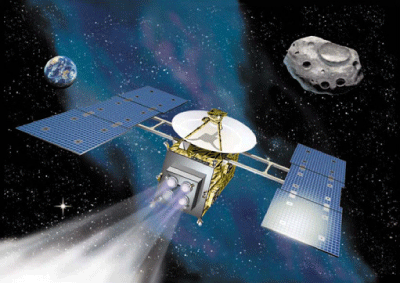TOP > Topics > 2003 > Ion Engines Aboard “HAYABUSA” Is Very Smooth
![]()
Ion Engines Aboard “HAYABUSA” Is Very Smooth
The asteroid explorer “HAYABUSA (MUSES-C)”, launched from the Kagoshima Space Center (KSC) on May 9, 2003, is smoothly cruising. At present, it is located 75 million km far behind earth, equivalent to half the distance between the Sun and earth.
Let’s look back on the history of HAYABUSA. At 1:29 p.m. on May 9, the M-V-5 rocket carrying MUSES-C disappeared with a roar into the blue sky before the rainy season. By receiving telemetry data at the Goldstone Tracking Station, it was found that MUSES-C was almost accurately put into the planned orbit. And MUSES-C was renamed HAYABUSA. Four ion engines installed on the explorer are driving force for the long journey reaching 1 billion km on the round-trip between earth and the asteroid “ITOKAWA”.
From end May, we began carefully plasma ignition and ion acceleration of the engines one by one. It was our unexpected pleasure that the Doppler shift of communication radio wave allowed us to monitor the acceleration status of HAYABUSA by the ion engines in real time. In order to enable acceleration of HAYABUSA by itself without monitoring from earth, we adjusted the driving parameters and rewrote the computer program. From July 2003, HAYABUSA started the cruising operation.
The ion engines operated almost every day and speed-up of about 4m/s a day has been achieved. In end November 2003, HAYABUSA encountered the biggest solar flare in history, but went through it safely. Since the acceleration amount planned in 2003 was achieved on December 22, the ion engine operation in the year was stopped, reaching the accumulated operation of 8,147 hours/unit. Though we will resume the ion engine acceleration in late January 2004 for trajectory change, it is judged that the trajectory enabling to meet earth again in around June 2004 has been almost accomplished. When approaching earth in June, we will perform the earth swingby where the HAYABUSA’s velocity vector will be bent by the earth’s gravity for orienting its trajectory toward the asteroid. After that, HAYABUSA will further fire the ion engines and rendezvous with the asteroid ITOKAWA in 2005
Now, let me briefly introduce the ion engine. The ion engine is to accelerate the electrically charged ion particles, which are ionized from the propellant xenon, using voltage difference of more than 1kV. Then, at the downstream the particles become neutral plasma by mixing with electrons. Reaction of high-speed plasma injection generates the driving force. The ion engine with the advantage of high propellant efficiency is an essential technology for the deep space cruising. There are several methods to produce ions and electrons. HAYABUSA employs the micro wave discharge type ion engine “Mu 10 (É 10)”, which was developed by the electric propulsion engineering section at the Institute of Space and Astronautical Science of JAXA. The outstanding feature of this engine is that long life and high reliability are expected. Because, since it doesn’t use the discharge electrodes for plasma generation, there is no concern of deterioration. The operation record of 8,000 hours/unit in space achieved in 2003 is the world-class accomplishment while countries in the world are competing for practical use of the electric propulsion technology.
|
(Hitoshi Kuninaka)
December 26, 2003





